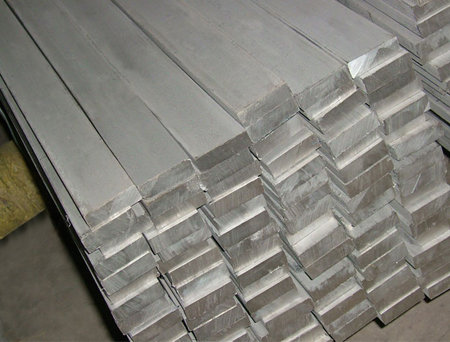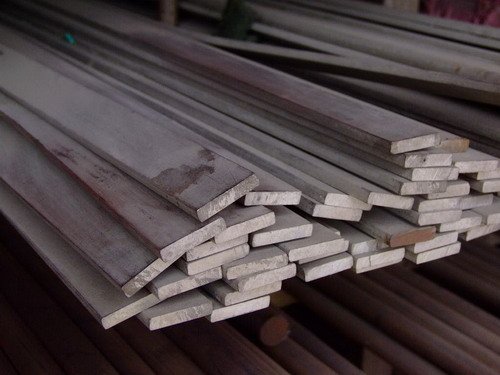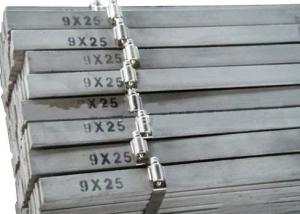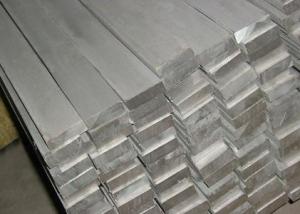Stainless Steel Flats,JISHUN
- Loading Port:
- China Main Port
- Payment Terms:
- TT or LC
- Min Order Qty:
- 5 Tons m.t.
- Supply Capability:
- 1000 Tons Per Month m.t./month
OKorder Service Pledge
OKorder Financial Service
You Might Also Like
Stainless Steel Flats
1. Standard: AISI, GB, JIS, ASTM, DIN, EN
2. Grade: 1).200Series: 201,202.
2).300Series: 301,302,303,304,304L,316,316L,321.
3).400Series: 410,410S,416,420,430,430F.
3. Size:3x25mm- 80x250mm
4. Length: 2m-6m
5. Craft: HRAP, or cold drawn
6. Stainless Steel Flat Bar Surface: Pickling or polished
7. MOQ: 1 Ton
8. Delivery: within 20 days
9. Package: Waterproof with tape
10. Application: These products are widely supplied to areas of machine-made industry, chemical industry, shipping industry,architecture, food industry, household products etc.
|
Size |
Thickness (mm) | |||||||||||
|
Width (mm) |
3 |
4 |
5 |
6 |
8 |
10 |
12 |
14 |
16 |
20 |
25 |
30 |
|
Theoretical Weight (kg/m) | ||||||||||||
|
10 |
0.238 |
0.32 |
0.4 |
0.48 |
0.63 |
|
|
|
|
|
|
|
|
15 |
0.36 |
0.48 |
0.59 |
0.71 |
0.95 |
1.19 |
|
|
|
|
|
|
|
20 |
0.476 |
0.63 |
0.79 |
0.95 |
1.27 |
1.59 |
1.9 |
|
|
|
|
|
|
25 |
0.585 |
0.79 |
0.99 |
1.19 |
1.59 |
1.98 |
2.38 |
|
|
|
|
|
|
30 |
0.714 |
0.95 |
1.19 |
1.43 |
1.9 |
2.38 |
2.85 |
3.33 |
3.81 |
4.75 |
5.948 |
|
|
40 |
0.952 |
1.27 |
1.59 |
1.9 |
2.54 |
3.17 |
3.81 |
4.44 |
5.08 |
6.34 |
7.93 |
9.52 |
|
50 |
1.19 |
1.59 |
1.98 |
2.38 |
3.17 |
3.97 |
4.76 |
5.55 |
6.34 |
7.93 |
9.91 |
11.9 |
|
60 |
1.428 |
1.9 |
2.38 |
2.85 |
3.81 |
4.76 |
5.71 |
6.66 |
7.61 |
9.52 |
11.9 |
14.27 |
|
70 |
|
2.22 |
2.78 |
3.33 |
4.44 |
5.55 |
6.66 |
7.77 |
8.88 |
11.1 |
13.88 |
16.65 |
|
80 |
|
|
3.17 |
3.81 |
5.08 |
6.34 |
7.61 |
8.88 |
10.15 |
12.69 |
15.86 |
19.03 |
|
90 |
|
|
3.57 |
4.28 |
5.71 |
7.14 |
8.56 |
9.99 |
11.42 |
14.27 |
17.84 |
21.41 |
|
100 |
|
|
3.97 |
4.76 |
6.34 |
7.93 |
9.52 |
11.1 |
12.69 |
15.86 |
19.82 |
23.79 |
|
110 |
|
|
|
5.23 |
6.98 |
8.72 |
10.47 |
12.21 |
13.96 |
17.45 |
21.81 |
26.17 |
|
120 |
|
|
|
5.71 |
7.61 |
9.52 |
11.42 |
13.32 |
15.23 |
19.03 |
23.79 |
28.55 |
|
130 |
|
|
|
6.19 |
8.25 |
10.31 |
12.37 |
14.43 |
16.49 |
20.62 |
25.77 |
30.93 |
|
140 |
|
|
|
6.66 |
8.88 |
11.1 |
13.32 |
15.54 |
17.76 |
22.2 |
27.76 |
33.31 |
|
150 |
|
|
|
7.14 |
9.52 |
11.9 |
14.27 |
16.65 |
19.03 |
23.79 |
29.74 |
35.69 |
|
160 |
|
|
|
7.61 |
|
12.69 |
15.23 |
17.76 |
20.3 |
25.38 |
31.72 |
38.06 |
|
170 |
|
|
|
|
|
13.48 |
16.18 |
18.87 |
21.57 |
26.96 |
33.7 |
40.44 |
|
180 |
|
|
|
|
|
14.27 |
17.13 |
19.98 |
22.84 |
28.55 |
35.69 |
42.82 |


- Q:304 stainless steel tube with the diameter of 25*2-3 is what mean
- The quality of the steel pipe should be in line with the national standard "stainless steel seamless pipe for fluid transportation" (GBT 14976-2012) requirements.
- Q:Can stainless steel pipes withstand high temperatures?
- Yes, stainless steel pipes can withstand high temperatures due to their excellent heat resistance properties.
- Q:What is the difference between seamless and seamless annealed stainless steel pipes?
- The main difference between seamless and seamless annealed stainless steel pipes lies in their manufacturing process and the resulting properties of the pipes. Seamless stainless steel pipes are manufactured by piercing a hot billet or a solid bar to form a hollow cylindrical shape. This process eliminates the need for welding or any other joints, resulting in a uniform and continuous pipe with no seams. Seamless pipes are known for their excellent strength and ability to withstand high pressures, making them suitable for various applications in industries such as oil and gas, petrochemical, and construction. On the other hand, seamless annealed stainless steel pipes go through an additional heat treatment process called annealing. Annealing involves heating the pipe to a specific temperature, holding it at that temperature for a certain duration, and then cooling it slowly. This heat treatment helps to relieve internal stresses, reduce hardness, improve ductility, and enhance the overall mechanical properties of the stainless steel pipe. The annealing process also leads to the formation of a more homogenous microstructure, which further improves the corrosion resistance of the stainless steel. This makes seamless annealed stainless steel pipes particularly suitable for applications where excellent corrosion resistance is required, such as in the chemical processing, pharmaceutical, and food and beverage industries. In summary, while both seamless and seamless annealed stainless steel pipes are produced without any seams, the additional annealing process in the latter enhances its mechanical properties and corrosion resistance, making it more suitable for certain industries and applications.
- Q:How do you prevent pitting corrosion in stainless steel pipes?
- To avoid pitting corrosion in stainless steel pipes, there are several steps that can be taken: 1. Select the appropriate grade of stainless steel: Not all stainless steels are equal. Opt for grades that have higher corrosion resistance, such as 316 or 904L, which contain molybdenum and offer better protection against pitting corrosion. 2. Ensure proper alloy composition: Make sure that the stainless steel pipe contains the correct amount of alloying elements like chromium and molybdenum. These elements create a protective layer on the steel's surface, enhancing its resistance to corrosion. 3. Regularly clean and maintain the pipes: Clean the stainless steel pipes on a regular basis to remove any contaminants or deposits that could contribute to pitting corrosion. Avoid using abrasive materials or cleaners that might harm the protective layer. 4. Minimize exposure to aggressive environments: Reduce the stainless steel pipes' exposure to aggressive substances such as chloride ions, acidic solutions, or high temperatures, as these can accelerate pitting corrosion. If exposure is unavoidable, consider applying protective coatings or linings to create a barrier between the steel and the corrosive environment. 5. Employ cathodic protection methods: Implement techniques like sacrificial anode systems or impressed current systems to safeguard the stainless steel pipes. These methods create a potential difference between the stainless steel and a more susceptible metal, diverting corrosion away from the stainless steel. 6. Control water chemistry: If the pipes are used in water applications, monitor and control parameters such as pH, temperature, and chloride levels. Adjusting these factors within acceptable limits can help prevent pitting corrosion. 7. Adhere to proper design and installation practices: Ensure that the stainless steel pipes are designed and installed correctly, considering factors such as avoiding crevices, ensuring proper drainage, and preventing stagnant areas where corrosion can occur. Proper insulation and the use of compatible gaskets or flanges can also prevent pitting corrosion. By following these preventive measures, the risk of pitting corrosion in stainless steel pipes can be significantly reduced, leading to a longer lifespan and maintained structural integrity.
- Q:How do stainless steel pipes compare to copper pipes?
- Stainless steel pipes and copper pipes are both widely used in various applications, but they have distinct characteristics that set them apart. One of the main differences between stainless steel pipes and copper pipes is their resistance to corrosion. Stainless steel pipes have excellent corrosion resistance, making them suitable for environments with high humidity or exposure to chemicals. Copper pipes, on the other hand, are also corrosion-resistant but not to the same extent as stainless steel. They may corrode over time when exposed to certain chemicals or acidic conditions. Another factor to consider is cost. Copper pipes are generally more expensive than stainless steel pipes. However, copper is a highly efficient conductor of heat and electricity, making it a preferred choice for applications that require heat transfer, such as plumbing and HVAC systems. Stainless steel pipes are also good conductors but are generally less expensive than copper pipes, making them a cost-effective alternative in many cases. In terms of durability, stainless steel pipes are known for their strength and ability to withstand high pressures, making them suitable for industrial applications and underground installations. Copper pipes are also durable but may be more prone to damage in extreme conditions or when exposed to excessive pressure. Ease of installation is another factor to consider. Copper pipes are relatively easy to work with due to their malleability, which allows for easy bending and shaping. Stainless steel pipes, on the other hand, are typically harder and require specialized tools for cutting and bending. In summary, stainless steel pipes offer superior corrosion resistance, are cost-effective, and are ideal for high-pressure applications. Copper pipes, on the other hand, have excellent heat transfer properties and are more malleable, making them suitable for plumbing and HVAC systems. Ultimately, the choice between stainless steel and copper pipes depends on the specific requirements of the application and the budgetary constraints.
- Q:Can stainless steel pipes be insulated with asbestos?
- No, stainless steel pipes should not be insulated with asbestos. Asbestos is a hazardous material that has been linked to serious health risks, including lung diseases and cancer. It is important to use safe and non-toxic insulation materials when insulating pipes to protect both the environment and human health.
- Q:Can magnets attract stainless steel tubes?
- There are two kinds of stainless steel, one is made of nickel as the main component of stainless steel, one is chromium as the main component of stainless steel. The magnet can absorb chromium containing stainless steel and can not suck nickel containing stainless steel.
- Q:Can stainless steel pipes be cold worked?
- Yes, stainless steel pipes can be cold worked. Cold working is a process that involves deforming the metal at room temperature, without the need for heating. Stainless steel, being a versatile and ductile material, can be easily cold worked to achieve desired shapes and sizes. Cold working methods such as bending, flaring, swaging, and drawing can be applied to stainless steel pipes to meet specific requirements. Cold working also enhances the strength and hardness of the stainless steel, making it suitable for various applications in industries such as construction, automotive, and manufacturing.
- Q:Can stainless steel pipes be used for chemical storage tanks?
- Yes, stainless steel pipes can be used for chemical storage tanks. Stainless steel is known for its excellent corrosion resistance properties, making it an ideal material for storing chemicals. It is resistant to a wide range of chemicals, including acids, alkalis, solvents, and gases. Additionally, stainless steel is a durable and strong material, ensuring the structural integrity of the storage tank. It is also easy to clean and maintain, making it suitable for storing different types of chemicals. However, it is important to consider the specific chemical properties and requirements before selecting stainless steel pipes for chemical storage tanks.
- Q:What is the difference between 17-4 and 15-5 stainless steel pipes?
- The composition and properties of 17-4 and 15-5 stainless steel pipes are the main points of distinction between them. 17-4 stainless steel is an alloy that undergoes precipitation hardening and contains approximately 17% chromium and 4% nickel. It also has significant amounts of copper, niobium, and tantalum, which contribute to its exceptional strength and resistance to corrosion. These pipes are well-known for their excellent mechanical properties, making them ideal for applications that demand high strength and toughness. They are commonly utilized in industries such as aerospace, defense, and oil and gas. On the other hand, 15-5 stainless steel is also a precipitation-hardening alloy, but it contains about 15% chromium and 5% nickel. Additionally, it has a higher copper content compared to 17-4 stainless steel. The inclusion of copper in 15-5 stainless steel enhances its corrosion resistance and improves its toughness. These pipes are frequently employed in applications that require a combination of strength, corrosion resistance, and good formability. They find use in industries such as marine, chemical processing, and food processing. In summary, the difference between 17-4 and 15-5 stainless steel pipes lies in their chromium, nickel, and copper content. 17-4 stainless steel offers higher strength and toughness, which makes it suitable for demanding applications. On the other hand, 15-5 stainless steel, with its increased copper content, provides improved corrosion resistance and formability, making it the preferred choice for certain industries.
1. Manufacturer Overview |
|
|---|---|
| Location | Hebei,China |
| Year Established | 2009 |
| Annual Output Value | Above US$1 million |
| Main Markets | Asia, Middle East,America |
| Company Certifications | CE, CCC, ISO90001 |
2. Manufacturer Certificates |
|
|---|---|
| a) Certification Name | |
| Range | |
| Reference | |
| Validity Period | |
3. Manufacturer Capability |
|
|---|---|
| a)Trade Capacity | |
| Nearest Port | Tianjin |
| Export Percentage | 0.3 |
| No.of Employees in Trade Department | 4 People |
| Language Spoken: | English;Chinese |
| b)Factory Information | |
| Factory Size: | Above 5,000 square meters |
| No. of Production Lines | 3 |
| Contract Manufacturing | OEM Service Offered;Design Service Offered |
| Product Price Range | Lower |
Send your message to us
Stainless Steel Flats,JISHUN
- Loading Port:
- China Main Port
- Payment Terms:
- TT or LC
- Min Order Qty:
- 5 Tons m.t.
- Supply Capability:
- 1000 Tons Per Month m.t./month
OKorder Service Pledge
OKorder Financial Service
Similar products
New products
Hot products
Hot Searches
Related keywords




























